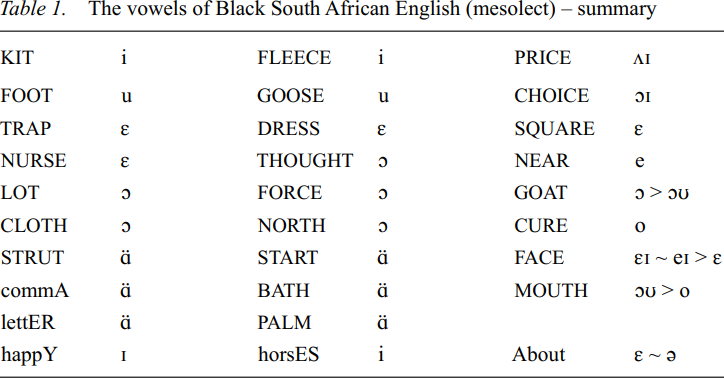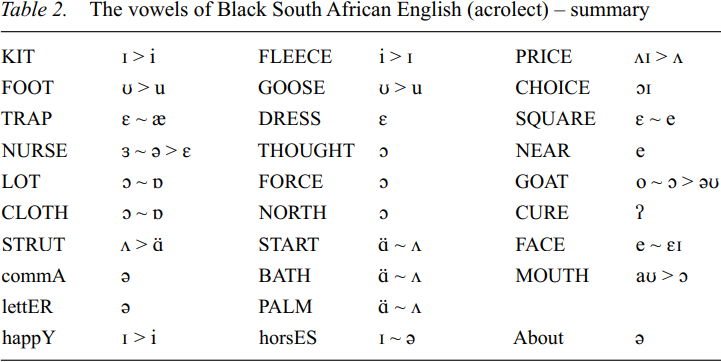


 Grammar
Grammar
 Tenses
Tenses
 Present
Present
 Past
Past
 Future
Future
 Parts Of Speech
Parts Of Speech
 Nouns
Nouns
 Verbs
Verbs
 Adverbs
Adverbs
 Adjectives
Adjectives
 Pronouns
Pronouns
 Pre Position
Pre Position
 Preposition by function
Preposition by function 
 Preposition by construction
Preposition by construction
 Conjunctions
Conjunctions
 Interjections
Interjections
 Grammar Rules
Grammar Rules
 Linguistics
Linguistics
 Semantics
Semantics
 Pragmatics
Pragmatics
 Reading Comprehension
Reading Comprehension|
Read More
Date: 2024-03-18
Date: 2024-04-01
Date: 2024-02-22
|
Like most other African varieties of English, BlSAfE is characterized by the absence of the tense/lax contrast and central vowels in the mesolectal variety. The typical realizations of vowels are represented in Table 1 below. The basis for the presentation in this table is the work of Van Rooy and Van Huyssteen (2000), but subsequent analyses were undertaken of data within the African Speech Technology project, particularly to refine the transcriptions of diphthongs.

The phonetic quality of the monophthongs, transcribed as tense vowels throughout, is in actual fact somewhat variable, and often a realization that is intermediate between a tense and lax vowel is found. For instance, it is not uncommon to find that the vowel in both FLEECE and KIT are realized with a first formant value of 350Hz and second formant of just below 2000Hz by male speakers. Vowel length is variable. In terms of our current understanding, there is no systematic use of vowel length to distinguish between pairs like FLEECE and KIT, but lengthening may take place as cue for stress placement. Thus, length may perform a suprasegmental function, but it is not distinctive at phonemic level.
Central vowels are realized as mid front vowels or as central low vowels. Typically, the tense vowel in NURSE is realized as [ε]. A schwa in the final syllable of native varieties of SAfE, particularly if the syllable is open, is usually realized as a low vowel in BlSAfE, transcribed as  in Table 1 above, but its phonetic quality ranges from slightly backed to slightly fronted. In the majority of all cases, the second formant value of this vowel is below 1500Hz for male voices, but seldom below 1300Hz.
in Table 1 above, but its phonetic quality ranges from slightly backed to slightly fronted. In the majority of all cases, the second formant value of this vowel is below 1500Hz for male voices, but seldom below 1300Hz.
More variability is observed with the realization of the vowel in the first syllable of About, and other unstressed vowels that do not occur in final syllables. Previous research (particularly Van Rooy and Van Huyssteen 2000) suggests that in syllables other than open final syllables, the dominant allophone for native varieties’ schwa is [ε], while the allophone [ə] is also observed but with less frequency. An analysis of further data from the African Speech Technology databases suggests that the frequency of schwa might actually be higher, although distributed slightly differently than in native varieties of English, because of differences in stress placement between mesolect BlSAfE and other varieties, but the main finding remains that the forms [ε] and [ə] are the two variants in perhaps roughly equal distribution and by far the two most frequent forms in unstressed syllables. There also appears to be a preference for letter pronunciation, selecting the allophone [ɔ], in the case of items spelled with the letter ‘o’ in unstressed syllables, such as the second syllable of the word ‘opportunity’. Finally, while the examples analyzed are not sufficient to allow a definite statement, there appears to be a tendency (80% or more of the analyzed cases, but type frequency low in the corpus) to pronounce a lax [ɔ] in final closed syllables between a labial obstruent in onset position and a final lateral [l], for example in the words ‘double’ or ‘careful’.
In summary, there are essentially five contrastive vowel phonemes in mesolectal BlSAfE: /i/ , /ε/ , /a/ , /ɔ/ and /u/. Perception studies by Wissing (2002) confirm this phonemic structure of mesolect BlSAfE, and also indicate that there is very little difference between BlSAfE speakers with different native languages.
The diphthongs are very often realized as monophthongs. Van Rooy and Van Huyssteen (2000) claim that more centralized acoustic values are used, but maintain that too little tongue movement (as judged by an analysis of movement in the first and second formant values) takes place to warrant transcription of these phones as diphthongs. Subsequent analysis of diphthongs in the African Speech Technology speech corpus reveals that a number of diphthongs are found, particularly in PRICE, CHOICE, FACE and MOUTH, and sometimes also in GOAT. These diphthongs are all rising diphthongs, and are realized as diphthongs in most varieties of English. The remainder of the diphthongs of SAfE, the centring diphthongs that occur in the words SQUARE, NEAR and CURE, are almost always realized as monophthongs in BlSAfE, but this happens in other varieties of English as well, notably many American English varieties. Since mesolectal forms of BlSAfE avoid central vowels otherwise, it is not surprising that these diphthong phonemes that have a central vowel as their offset target are realized by monophthong phones. One can conclude that there are six contrastive phonemes, additional to the five used for monophthongs, which are mainly used for the diphthongs of native varieties of SAfE: /Λɪ/ , /ɔɪ/ , /aʊ/ , /eɪ/ , /e/ and /o/. Hundleby (1963) and others after him have claimed to observe the occurrence of vowel-glide-vowel sequences as realizations of the diphthongs in the speech of BlSAfE. While a small number of such cases were observed in the data, they account for less than 1% of the realizations of all the vowel types represented by diphthongs in SAfE, and less than 10% for any one of the separate vowel types. Also, there is no indication of a systematic use of vowel length to realize the diphthong phonemes, with no single diphthong having a long vowel allophone in more than 20% of all observed cases.
As pointed out earlier, it is important to consider differences between the pronunciation of the acrolect and mesolect varieties of BlSAfE. Apart from Hundleby (1963), such differences have not received serious consideration. In the discussion to follow, I rely on results of my own on-going research into this variety.

A comparison between the mesolect and acrolect data suggests that the acrolect is closer to native varieties of SAfE in many respects, but at the same time, it is characterized by more variability rather than less. A particularly noteworthy property of the acrolect is the use of both tense and lax monophthong phonemes. In some cases, there is a degree of contrast between pairs such as KIT x FLEECE, LOT x NORTH and STRUT x START, but many exceptions are also observed. In the case of the pair FOOT x GOOSE, the lax allophone occurs far more frequently than the tense allophone, but no consistent contrast/opposition is maintained.
Related to the use of lax vowels in the acrolect form is the use of central vowels, and most significantly, the schwa. Reduced vowels occur in the acrolect form of BlSAfE in ways very similar to native varieties of SAfE, and the low vowel phone as realization of a native schwa has disappeared almost completely.
In comparison to the five phonemes of the mesolect, /i/, /ε/, /a/, /ɔ/ and /u/, the acrolect also uses /ɪ/ , /з/ and /Λ/ as phonemes, with /æ/ and /ɒ/ emerging as phonemes, although not with enough consistency to regard them as established phonemes yet.
The diphthongs are perhaps the area where the acrolect and mesolect are more similar than other aspects of the vowel system. Lots of variation is observed in the speakers’ rendition of the phonemes represented by the words in Table 2. In general, variants of the same five diphthongs, the rising diphthongs, occur that also occur in the mesolect, while the centring diphthongs are realized as monophthongs in the acrolect as well. At the time of writing, I have insufficient evidence about the realization of the vowel in cure to make any strong claims, but suspect that it will be realized as monophthong [o], similar to the mesolect. There are no further diphthong phonemes in the speech of the acrolect speakers, as compared to the mesolect speakers.
One last comment must be made about the vowel pronunciation of BlSAfE. In white native varieties of SAfE, there is a unique vowel contrast, usually represented by the pair KIT vs. SIT. KIT is pronounced similar to major British varieties, but SIT is realized with a vowel quality closer to schwa, or at least a much more centralized variant of [ɪ] . In the mesolectal variety of BlSAfE, both these words are realized by a high front vowel, but in the acrolect form, the contrast is sometimes maintained, with the allophones [ɪ] and [ə] both observed with roughly equal frequency. Thus, while not with the same consistency of native varieties of SAfE, acrolect BlSAfE has an emerging contrast between KIT and SIT too.
|
|
|
|
لخفض ضغط الدم.. دراسة تحدد "تمارين مهمة"
|
|
|
|
|
|
|
طال انتظارها.. ميزة جديدة من "واتساب" تعزز الخصوصية
|
|
|
|
|
|
|
عوائل الشهداء: العتبة العباسية المقدسة سبّاقة في استذكار شهداء العراق عبر فعالياتها وأنشطتها المختلفة
|
|
|